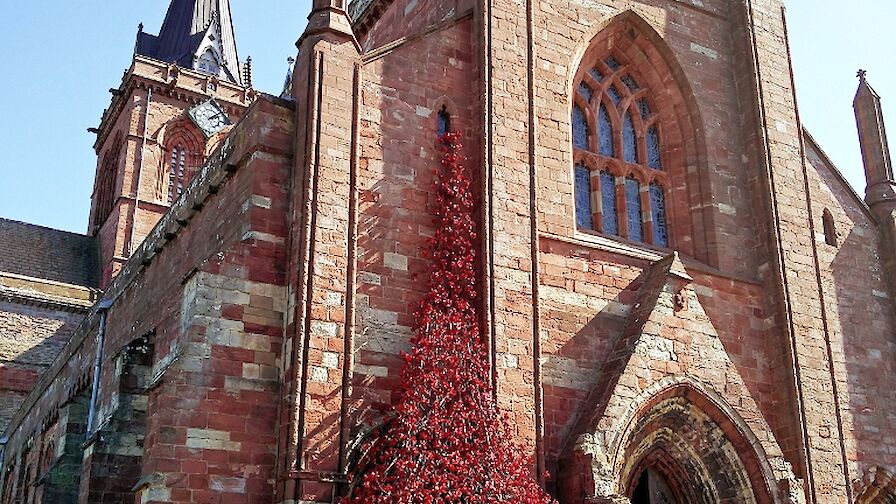Thousands of ceramic poppies have gone on display at Orkney's St Magnus Cathedral. The installation marks the start of Orkney's role in the national commemoration of the centenary of the Battle of Jutland.
St Magnus Cathedral has always been the jewel in Kirkwall's crown, but it has never looked quite as dramatic as it does at the moment. Blood red poppies are cascading from a small window high above the Kirk Green before spilling out onto the grass below.

The breath-taking sculpture, by artist Paul Cummins and designer Tom Piper, is part of 14-18 NOW, the UK's arts programme for the First World War Centenary. Alongside Wave, a sweeping arch of bright red poppy heads suspended on towering stalks, it was initially conceived as one of the key dramatic sculptural elements in the installation Blood Swept Lands and Seas of Red at the Tower of London in the autumn of 2014.
The Cathedral is the first venue in Scotland to host the display, which forms part of plans to mark the centenary of the Battle of Jutland in Orkney. Locals and visitors are stopping to take in the beautiful sight which provides a splash of colour and poignancy in the heart of the town's historic town centre.

The display is open until the 12th of June. There are interpretation boards for visitors and Cathedral staff and Volunteer Hosts will be on hand between 9am and 8pm, Monday - Sunday, to answer questions and provide further information about the artwork. Visitors are advised to consider their transport and parking arrangements before visiting the artwork due the popularity of the installation. To find out more about Orkney's First World War History, visit Orkney Museum's summer exhibition at Tankerness House, Kirkwall (opposite St Magnus Cathedral) and the Scapa Flow Visitor Centre and Museum in Lyness, Hoy.
Orkney will host the UK's national commemoration of the Battle of Jutland at the end of May with a series of events planned across the islands. Jutland was the most significant naval engagement of the First World War, with over 100,000 sailors involved on 250 ships. More than 6,000 Royal Navy and 2,500 German sailors lost their lives.

In Orkney there will be a morning service on the 31st of May at St Magnus Cathedral, followed by a ceremony and time for reflection at the Lyness Royal Naval Cemetery in Hoy, where over 400 Commonwealth servicemen and German sailors from the First World War are buried. Some were as young as 16 years old.
Exhibitions, tours and talks - as well as visits from Royal Navy vessels - will be held throughout the week, culminating on the 5th of June with an event to commemorate the loss of 737 men, including the Secretary of State for War Lord Kitchener, when HMS Hampshire was sunk by a mine west of Orkney off Marwick Head.
Orkney is expected to be very busy during the commemorative events but many exhibitions are running for the duration of the summer. You can book your accommodation through the Visit Orkney website.





